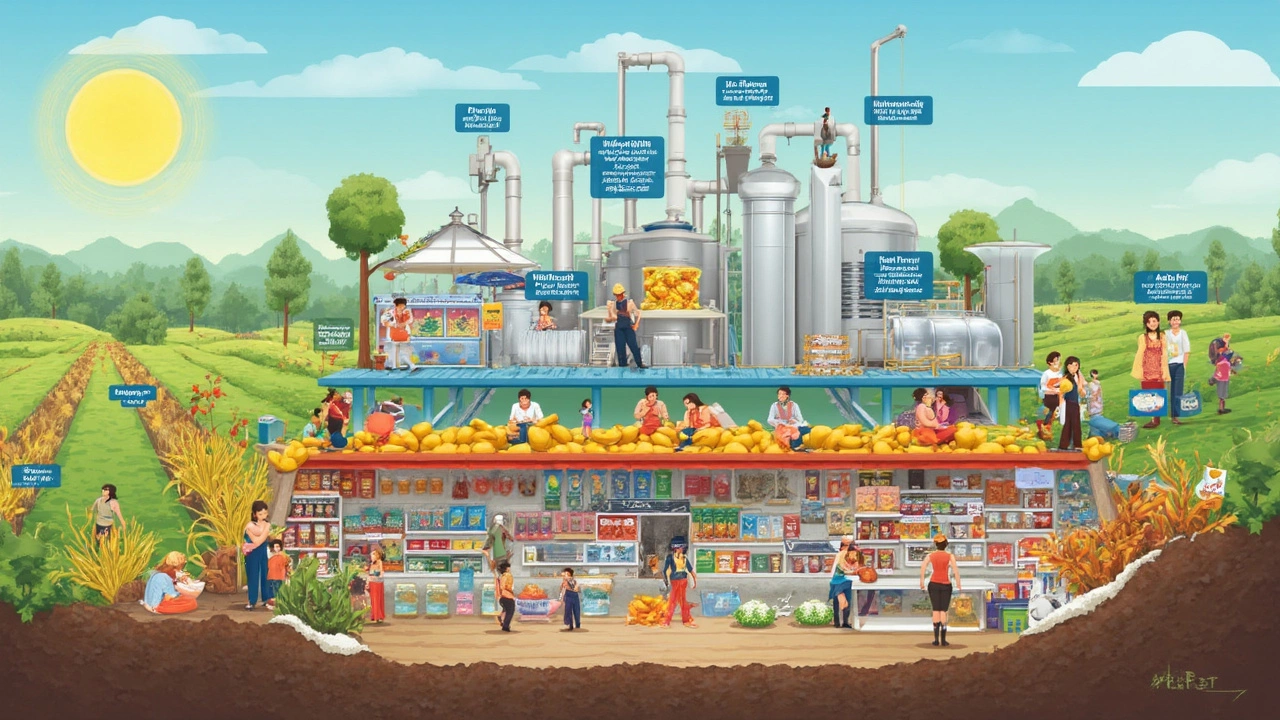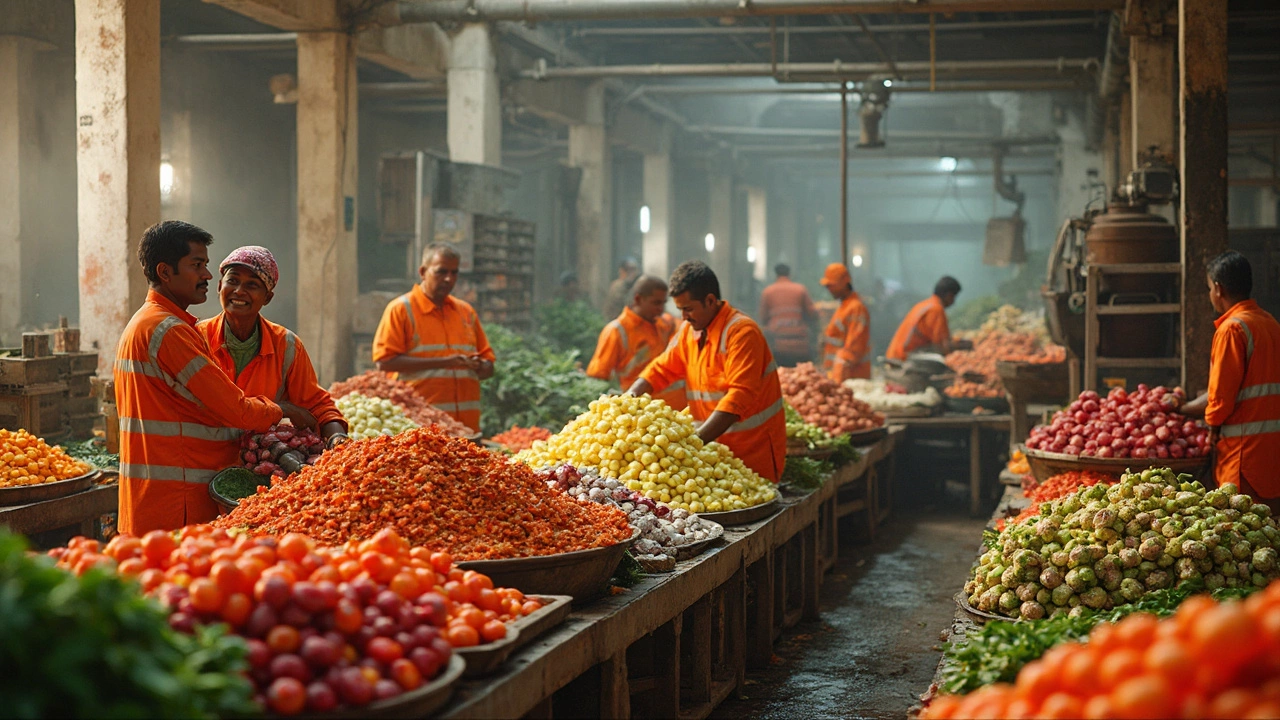Ever wondered why a simple rice grain looks so different from your favorite breakfast cereal? That’s all about the levels of food processing. The whole system is broken down into three main stages, and getting these right can mean the difference between safe, tasty food and something you’d rather skip.
Knowing these levels isn't just for big factories. Even if you run a small café, make snacks at home, or want to understand what’s in your fridge, these steps explain a lot. You’ll see why farmers wash and bag veggies, why your yogurt tastes different from fresh milk, and how that microwave meal gets its shelf life.
No need to wade through technical jargon here. We’ll run through each level, show real examples, and toss in some tips so you can spot what stage your favorite foods are at. It's way more interesting than it sounds—and way more useful, too.
- Why Understanding Processing Levels Matters
- Level 1: Primary Processing—Where It All Begins
- Level 2: Secondary Processing—Transforming Raw Goods
- Level 3: Tertiary Processing—Ready for the Shelf
- Practical Tips for Setting Up Each Level
- What’s Next for Food Processing Units?
Why Understanding Processing Levels Matters
Knowing the three stages of food processing doesn’t just help the folks running giant factories. If you work in a small food business, help with local snacks, or just care about what you and your family eat, these levels explain a lot. They tell you exactly what’s been done to your food along the way, and they can even help you figure out which foods are fresher or potentially healthier.
Food safety is one of the big reasons people pay attention to processing. At each level, there are important checkpoints. For example, primary processing gets rid of dirt and bacteria, while secondary processing can kill harmful bugs with heat or chemicals. Missing a step or doing it wrong can cause food poisoning—no one wants that.
If you’re running or working in any kind of food processing business, understanding these levels also helps with planning and costs. Some steps need pricey equipment, better packaging, or trained workers. It’s easier to set a fair price or pick suppliers if you know what’s involved at each stage.
| Level | Main Goal | Common Example |
|---|---|---|
| Primary | Initial cleaning or sorting | Washing fruits, milling wheat |
| Secondary | Turning raw items into new products | Baking bread, making cheese |
| Tertiary | Making food shelf-stable or convenient | Frozen pizzas, instant noodles |
Here’s another tip: Labels don’t always tell you which processing level a food is at. Knowing what these steps mean can help you ask better questions or spot the stuff that fits your needs, whether that’s for business or just a better meal at home.
Level 1: Primary Processing—Where It All Begins
This is the stage where raw crops and animal products start their journey. Primary processing is all about turning things like wheat, rice, milk, or meat from their natural state into something safer or easier to move and store. Think of it as prepping the food before anything fancy happens to it.
You can see primary processing at work on farms, in dairy collection centers, and even at seafood docks. It’s about tasks like cleaning, grading, sorting, milling, slaughtering, and chilling. For grains, this means removing dirt, stones, and husks. For milk, that’s chilling and filtering. None of this changes the basic nature of the food—you’re just making it ready for what comes next.
"Primary processing is the backbone of the food industry, setting standards for everything that follows," says Dr. Rashmi Singh from the Indian Institute of Food Processing Technology.
Here’s a rundown of some common primary processing steps:
- Cleaning: Getting rid of stones, dust, and leaves from grains or fruits.
- Sorting and Grading: Grouping produce by size or quality—like sorting apples so the big ones go to markets, small ones to juice factories.
- Milling: Turning wheat into flour or paddy into rice.
- Chilling: Lowering the temperature of milk or meat to keep it fresh until further use.
- Slaughtering: Preparing meat for further processing or direct sale.
Here’s a quick peek at some numbers from the food industry, showing tons of output at the primary stage in 2024:
| Product | India Output (Million Tons) |
|---|---|
| Wheat (milled) | 109.6 |
| Milk (chilled/processed) | 230 |
| Fish (primary processed) | 15 |
| Rice (dehusked) | 135 |
Skipping or messing up primary processing brings problems—stuff like faster spoilage, less value, or even safety risks down the road. If you’re looking to start small with food processing, focusing on this level is where you want to get things right first. Good gear, clean water, and steady cold storage make all the difference here.
Level 2: Secondary Processing—Transforming Raw Goods
This is where the magic really happens in food processing. After the basics—like cleaning and sorting—secondary processing steps in to turn raw ingredients into actual food products you recognize or buy at the store. Think about wheat turning into bread, milk being made into cheese, or potatoes becoming fries.
Secondary processing combines ingredients, changes their structure, and boosts shelf life. It isn’t just about taste—it's also about safety. Baking, fermenting, blending, and packaging all fit into this stage. If you like yogurt, pasta, or even your morning toast, you’re eating the results of secondary processing.
- Baking: Turning dough (flour + water + yeast) into bread and pastries involves heat, changing texture and flavor.
- Fermenting: Bacteria or yeast help make products like cheese, yogurt, and pickles. This also increases nutrition and shelf life.
- Blending and Mixing: Mixing sauces, snack bars, or seasonings so you get uniform taste in every bite.
- Cooking and Pasteurizing: Ingredients are heated to destroy germs and improve texture. Pretty much all canned food goes through this.
You’d be surprised how much of your daily food comes from this step. Here’s a table showing how much processed food is part of the average diet in different countries, based on a 2023 survey:
| Country | % Calories from Secondary Processed Foods |
|---|---|
| USA | 62% |
| UK | 57% |
| India | 38% |
| Brazil | 44% |
Want to cut down on unhealthy stuff? Start by reading labels. Processed foods often come with extra sugar, salt, or preservatives. But not all are bad—some, like milk pasteurization or cheese making, actually improve quality or make food safer. If you're running your own processing unit, keeping equipment super clean and following standard recipes can make your products safer and more consistent.

Level 3: Tertiary Processing—Ready for the Shelf
When you grab a packet of chips, heat-and-eat noodles, or a frozen pizza, you’re dealing with tertiary processing. This is the final stage that turns already-processed ingredients into stuff that's basically ready to eat with little or no work on your part. Think of it as convenience cranked to the max.
The focus at this level isn’t just taste and texture—it's about shelf life, safety, mass appeal, and branding. These foods are made to travel long distances, sit for months in a store, and still taste decent when you open them. The food industry pours resources into packaging, marketing, and testing at this stage.
Here’s what really happens in food processing units at the tertiary level:
- Multiple ingredients get blended, cooked, or baked in industrial kitchens.
- Preservatives and additives get mixed in for longer shelf life and better flavor.
- Products are packed—usually with vacuum sealing, cans, or special gas-flushed packages to keep things fresh.
- Lab tests look for safety, since one bad batch can affect thousands of items.
- Final products get branded, labeled, and sent off to stores or exported worldwide.
The stats are huge. According to the Food Processing Industry Report 2024, tertiary processed foods made up almost 40% of all food retail sales in India alone. People love them for speed and ease—even though there’s ongoing debate about nutrition and additives.
| Product Example | Key Tertiary Process | Average Shelf Life |
|---|---|---|
| Instant noodles | Frying, flavor coating, dehydration, packaging | 6-12 months |
| Frozen pizza | Baking, flash-freezing, vacuum packaging | 3-6 months |
| Packaged snacks (chips) | Frying/baking, salting/flavoring, nitrogen flushing | 4-8 months |
| Ready-to-drink fruit juices | Pasteurization, mixing, aseptic packaging | 4-12 months |
If you’re thinking of setting up your own tertiary processing unit, you’ll need to stay on top of food safety standards, labeling rules, and invest in solid packaging tech. The payoff? You get your product out to more people, with less risk of spoilage or complaints.
Bottom line: This level is where food gets its final polish—and becomes what most folks actually eat. Whether you call it "ultra-processed" or just "easy dinner," it shapes how and what people eat every day.
Practical Tips for Setting Up Each Level
Thinking about setting up your own food processing unit or making an upgrade? Here are some hands-on tips that work whether you’re handling tomatoes in your backyard or installing machines in a small factory. The process you use for each level really decides product quality, shelf life, and, honestly, whether customers come back for more.
Primary Processing is all about cleaning, sorting, or packing raw foods. It sounds simple, but don’t cut corners. Invest in decent washing tanks, airflow dryers, or basic conveyor belts if you’re going bigger. A USDA study shows that improper washing and sorting is behind over 70% of produce recalls in the US.
- Clean with potable water only—skip untreated sources, as bacteria love those.
- Grading tables or digital sorters can boost efficiency if you have high volumes.
- Label batches and track suppliers to make any recall fast and focused if it ever comes up.
Secondary processing is when you get into mixing, fermenting, baking, or packaging foods into new forms (think: turning wheat into bread). This stage is your chance to improve texture, flavor, and safety. Start small with blenders, mixers, or simple ovens. But don’t forget about temperature control: a study from the International Journal of Food Science found that just a 5°C slip during yogurt fermentation can slash shelf life by nearly 40%.
- Use digital thermometers to keep your cooking or fermenting temps tight.
- Food-safe surfaces pay off. Stainless steel is king for cleanliness and quick sanitizing.
- Store your ingredients in labeled, sealed containers to keep out air and bugs.
Tertiary processing gets products shelf-ready—packing, branding, and sometimes freezing or adding preservatives. Good packaging makes your food last and look better. According to Statista, flexible packaging is now used in 63% of global snack food sales because it’s lighter, cheaper, and seals flavors in.
- Pick packaging based on your actual shelf life needs; overkill just adds costs.
- Automate labeling and sealing when you can; it’s faster and keeps standards even.
- Don’t forget about food safety checks—spot inspections catch most surprises before your customer does.
"Food quality and safety in processing start the moment you handle the raw ingredient—automation helps but real success depends on people following simple, clear routines daily." – Janet M., Food Processing Engineer
| Level | Main Equipment | Key Risk | Pro Tip |
|---|---|---|---|
| Primary | Washing tanks, graders, dryers | Contamination | Use potable water and track every lot |
| Secondary | Mixers, ovens, fermenters | Poor temp control | Check temperatures with digital tools |
| Tertiary | Sealers, labelers, freezers | Poor packaging | Choose packaging that matches shelf needs |
No matter what you process, consistency is your best friend. Don’t be afraid to start small and scale up once you nail the basics. And always keep an eye on new tech—sometimes a simple upgrade makes work way easier. That’s how the big names in food processing got where they are.
What’s Next for Food Processing Units?
Food processing units are changing fast. With customers looking for healthier choices and businesses facing tighter safety rules, the game is evolving. These units need to keep up with both trends and tech—or risk getting left behind.
Let’s talk about automation first. Machines are taking over repetitive jobs, cutting down on human mistakes, and saving time. For example, new robotic arms can grade, sort, and pack fruits in less than half the time it takes a person. This isn’t just about speed—it actually improves hygiene too, because there’s less human contact with food.
There’s another big thing: traceability. People want to know where their food comes from. QR codes and blockchain systems now let customers track an apple all the way from the farm to the supermarket. In 2024, around 45% of big food processors in India added some kind of advanced tracking to their labels. Food safety incidents? Easier to control and recall when you can trace a batch in seconds.
On the sustainability front, there’s heavier pressure to cut waste. Steam peeling for potatoes, for instance, saves up to 20% more produce compared to old methods. Solar dryers are popping up in rural areas, using nothing but sunshine to process spices and fruits, keeping costs—and emissions—down.
Here’s a snapshot of what’s trending in food processing units right now:
| Trend | Adoption Rate (2024, India) |
|---|---|
| Automation/Robotics | 37% |
| Advanced Traceability | 45% |
| Sustainable Tech (e.g. solar, water saving) | 42% |
| Plant-Based Product Processing | 29% |
If you’re working with or running a unit, here are actionable steps to stay ahead:
- Invest in automation for basic sorting and packaging. It pays off fast—even small machines can make a big difference in output.
- Add traceability options like QR codes, even if you’re not exporting. Customers love transparency, and it’s a selling point.
- Find ways to reuse or recycle waste. For example, vegetable scraps can become animal feed or biogas fuel.
- Keep an eye on plant-based foods. Demand’s rising. Simple adjustments in your food processing line—like allergen-safe cleaning between runs—can open new business.
The future’s about balancing quality, speed, and sustainability. Adapting isn’t just smart—it’s necessary if you want to keep your processing unit thriving in coming years.






